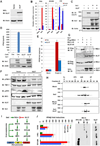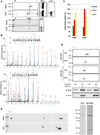A Viral Deamidase Targets the Helicase Domain of RIG-I to Block RNA-Induced Activation
- PMID: 27866900
- PMCID: PMC5159239
- DOI: 10.1016/j.chom.2016.10.011
A Viral Deamidase Targets the Helicase Domain of RIG-I to Block RNA-Induced Activation
Abstract
RIG-I detects double-stranded RNA (dsRNA) to trigger antiviral cytokine production. Protein deamidation is emerging as a post-translational modification that chiefly regulates protein function. We report here that UL37 of herpes simplex virus 1 (HSV-1) is a protein deamidase that targets RIG-I to block RNA-induced activation. Mass spectrometry analysis identified two asparagine residues in the helicase 2i domain of RIG-I that were deamidated upon UL37 expression or HSV-1 infection. Deamidation rendered RIG-I unable to sense viral dsRNA, thus blocking its ability to trigger antiviral immune responses and restrict viral replication. Purified full-length UL37 and its carboxyl-terminal fragment were sufficient to deamidate RIG-I in vitro. Uncoupling RIG-I deamidation from HSV-1 infection, by engineering deamidation-resistant RIG-I or introducing deamidase-deficient UL37 into the HSV-1 genome, restored RIG-I activation and antiviral immune signaling. Our work identifies a viral deamidase and extends the paradigm of deamidation-mediated suppression of innate immunity by microbial pathogens.
Keywords: ATPase/helicase; RIG-I; RNA-sensing; UL37; deamidation; herpesvirus; immune evasion.
Copyright © 2016 Elsevier Inc. All rights reserved.
Figures







Similar articles
-
Species-Specific Deamidation of RIG-I Reveals Collaborative Action between Viral and Cellular Deamidases in HSV-1 Lytic Replication.mBio. 2021 Mar 30;12(2):e00115-21. doi: 10.1128/mBio.00115-21. mBio. 2021. PMID: 33785613 Free PMC article.
-
The US3 Kinase of Herpes Simplex Virus Phosphorylates the RNA Sensor RIG-I To Suppress Innate Immunity.J Virol. 2022 Feb 23;96(4):e0151021. doi: 10.1128/JVI.01510-21. Epub 2021 Dec 22. J Virol. 2022. PMID: 34935440 Free PMC article.
-
RIG-I-Mediated STING Upregulation Restricts Herpes Simplex Virus 1 Infection.J Virol. 2016 Sep 29;90(20):9406-19. doi: 10.1128/JVI.00748-16. Print 2016 Oct 15. J Virol. 2016. PMID: 27512060 Free PMC article.
-
The Race between Host Antiviral Innate Immunity and the Immune Evasion Strategies of Herpes Simplex Virus 1.Microbiol Mol Biol Rev. 2020 Sep 30;84(4):e00099-20. doi: 10.1128/MMBR.00099-20. Print 2020 Nov 18. Microbiol Mol Biol Rev. 2020. PMID: 32998978 Free PMC article. Review.
-
Structures of RIG-I-Like Receptors and Insights into Viral RNA Sensing.Adv Exp Med Biol. 2019;1172:157-188. doi: 10.1007/978-981-13-9367-9_8. Adv Exp Med Biol. 2019. PMID: 31628656 Review.
Cited by
-
Innate Immune Evasion of Alphaherpesvirus Tegument Proteins.Front Immunol. 2019 Sep 13;10:2196. doi: 10.3389/fimmu.2019.02196. eCollection 2019. Front Immunol. 2019. PMID: 31572398 Free PMC article. Review.
-
Differential Requirements for gE, gI, and UL16 among Herpes Simplex Virus 1 Syncytial Variants Suggest Unique Modes of Dysregulating the Mechanism of Cell-to-Cell Spread.J Virol. 2019 Jul 17;93(15):e00494-19. doi: 10.1128/JVI.00494-19. Print 2019 Aug 1. J Virol. 2019. PMID: 31092572 Free PMC article.
-
Modulation of Innate Immune Signaling Pathways by Herpesviruses.Viruses. 2019 Jun 21;11(6):572. doi: 10.3390/v11060572. Viruses. 2019. PMID: 31234396 Free PMC article. Review.
-
Viral evasion of the interferon response at a glance.J Cell Sci. 2023 Jun 15;136(12):jcs260682. doi: 10.1242/jcs.260682. Epub 2023 Jun 21. J Cell Sci. 2023. PMID: 37341132 Free PMC article. Review.
-
Crystal Structure of the N-Terminal Half of the Traffic Controller UL37 from Herpes Simplex Virus 1.J Virol. 2017 Sep 27;91(20):e01244-17. doi: 10.1128/JVI.01244-17. Print 2017 Oct 15. J Virol. 2017. PMID: 28768862 Free PMC article.
References
-
- Bidinosti M, Ran I, Sanchez-Carbente MR, Martineau Y, Gingras AC, Gkogkas C, Raught B, Bramham CR, Sossin WS, Costa-Mattioli M, et al. Postnatal Deamidation of 4E–BP2 in Brain Enhances Its Association with Raptor and Alters Kinetics of Excitatory Synaptic Transmission. Molecular cell. 2010;37:797–808. - PMC - PubMed
-
- Chen ZJ, Parent L, Maniatis T. Site-specific phosphorylation of kappaBalpha by a novel ubiquitination-dependent protein kinase activity. Cell. 1996;84:853–862. - PubMed
MeSH terms
Substances
Grants and funding
LinkOut - more resources
Full Text Sources
Other Literature Sources
Molecular Biology Databases

